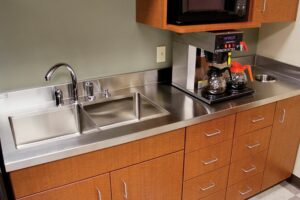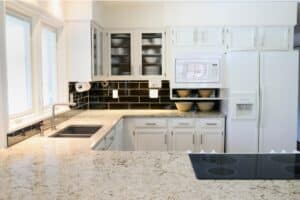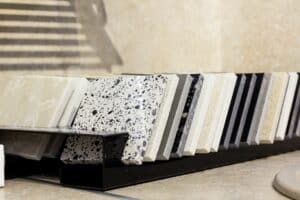If you find yourself immersed in the quest for a kitchen transformation, the endless deliberation over countertop options is likely familiar. Granite or marble? Laminate or quartz? Soapstone or stainless steel? And now, introducing another contender into the mix: copper. While not as ubiquitous as its countertop counterparts, this enduring favorite is gaining traction in popularity, making it a noteworthy addition to your list of considerations. Here’s the lowdown you need.
Copper Countertops Lookbook
Pros and Cons of Copper Countertops
PROS
Great Appearance
Escape the ordinary with copper countertops, a departure from the mundane plastic laminate and ceramic tile options that saturate kitchens. Copper’s arresting hues bring a unique touch, infusing warmth into your kitchen and creating an inviting space for family gatherings and social events.
Seamless Blending with Kitchen Elements
Unsealed copper countertops evolve over time, developing a distinctive patina in shades of red, brown, and green—a rustic charm that seamlessly complements country, farmhouse, and vintage decor styles. If your kitchen already boasts copper elements like sinks, range hoods, or light fixtures, a copper countertop serves as the perfect harmonious addition.
Long-lasting Brilliance
Properly maintained sealed countertops retain their luster, making them an excellent fit for modern decor. Whether you prefer the timeless appeal of an aged patina or the enduring shine of a sealed surface, both types of copper countertops offer character that allows you to design the rest of your kitchen around them.
Effortless Maintenance
Unlike countertops that demand specialized cleaning sprays and rigorous scrubbing, a copper countertop requires only a soft cloth and a simple mixture of soap and warm water to remove stubborn food residues and light stains. The patinated copper can be cleaned with a blend of lemon juice and table salt, offering not only a time-saving approach but also a cost-effective alternative to cleaning products.
On sealed copper surfaces, cleaning products designed for stainless steel or glass are effective, but caution is advised against cleaners containing citric acid, bleach, or ammonia, as these can dull the countertop’s shine and cause staining.
Hygienic
Certain types of copper possess inherent antimicrobial properties, creating an inhospitable environment for bacteria and viruses. In fact, copper alloys with natural antimicrobial qualities outperform stainless steel in microbial elimination. This not only reduces the risk of food-borne illnesses but also enhances overall kitchen hygiene.
Not all countertops share this advantage, though. To make claims about antimicrobial properties, manufacturers must register their product with the U.S. Environmental Protection Agency (EPA) after independent testing.
Environmentally Conscious Choice
Copper, being a natural material, sidesteps environmentally harmful manufacturing processes. As a durable metal with a lifespan of decades, copper maintains its strength over time, allowing it to be salvaged and recycled into countertops without compromising integrity. Should you tire of your countertop, selling it for scrap ensures a sustainable recycling journey for repurposing in other applications.
CONS
Changes in Appearance
Copper embodies the concept of a “living surface,” undergoing continuous changes in its appearance irrespective of the specific type of copper countertop chosen or the care it receives.
Matte copper gracefully transforms into an appealing reddish-brown tone over time. Prior to this development, the color may pass through a less appealing blotchy, brownish stage. If you prefer to bypass this phase or desire a more consistent color in the final patina, opting for professionally patinated copper is an alternative to letting the patina evolve naturally.
Ongoing Maintenance
While copper is easy to clean, it necessitates sealing with a protective layer of beeswax or butcher’s wax to ward off tarnishing. This protective measure ensures the countertop’s resilience against regular use. Neglecting this step accelerates tarnishing, and swift cleanup of spilled acidic liquids, like orange juice, is essential to prevent stains.
Vulnerability to Damage
Copper’s relative softness, compared to other metals, makes it susceptible to dents from hard object impacts, scratches from knives, and burn marks from hot cookware. Scratches on patinated copper appear more prominent, making concealment challenging. To preserve the countertop’s aesthetic, employing a cutting board and using pads under hot cookware is advisable.
Over time, the accumulation of dings contributes to a textured appearance. While minor damage can be buffed out, the time investment may render it impractical, resulting in a countertop with a distinct textured character.
Considerable Cost
Copper ranks among the most expensive countertop materials, averaging between $100 to $140 per sq. ft., with potential for even higher costs. Gauge significantly influences the expense, with heavier gauges commanding a higher price. Customizations, such as special finishes and texturing, further elevate the overall cost.
Heavier gauges of copper are favored for the rich patina, durability, and ease of maintenance, while lighter gauges maintain a bright shine, offering easier handling and lower installation costs. Regardless of gauge choice, professional installation is essential, adding to the overall expense.
For those seeking a countertop that infuses personality into the kitchen, embracing color variations and the unique character of dings and dents, copper emerges as an ideal choice. While it comes with a higher price tag, the longevity of copper, coupled with its evolving beauty, makes it a lasting investment.














